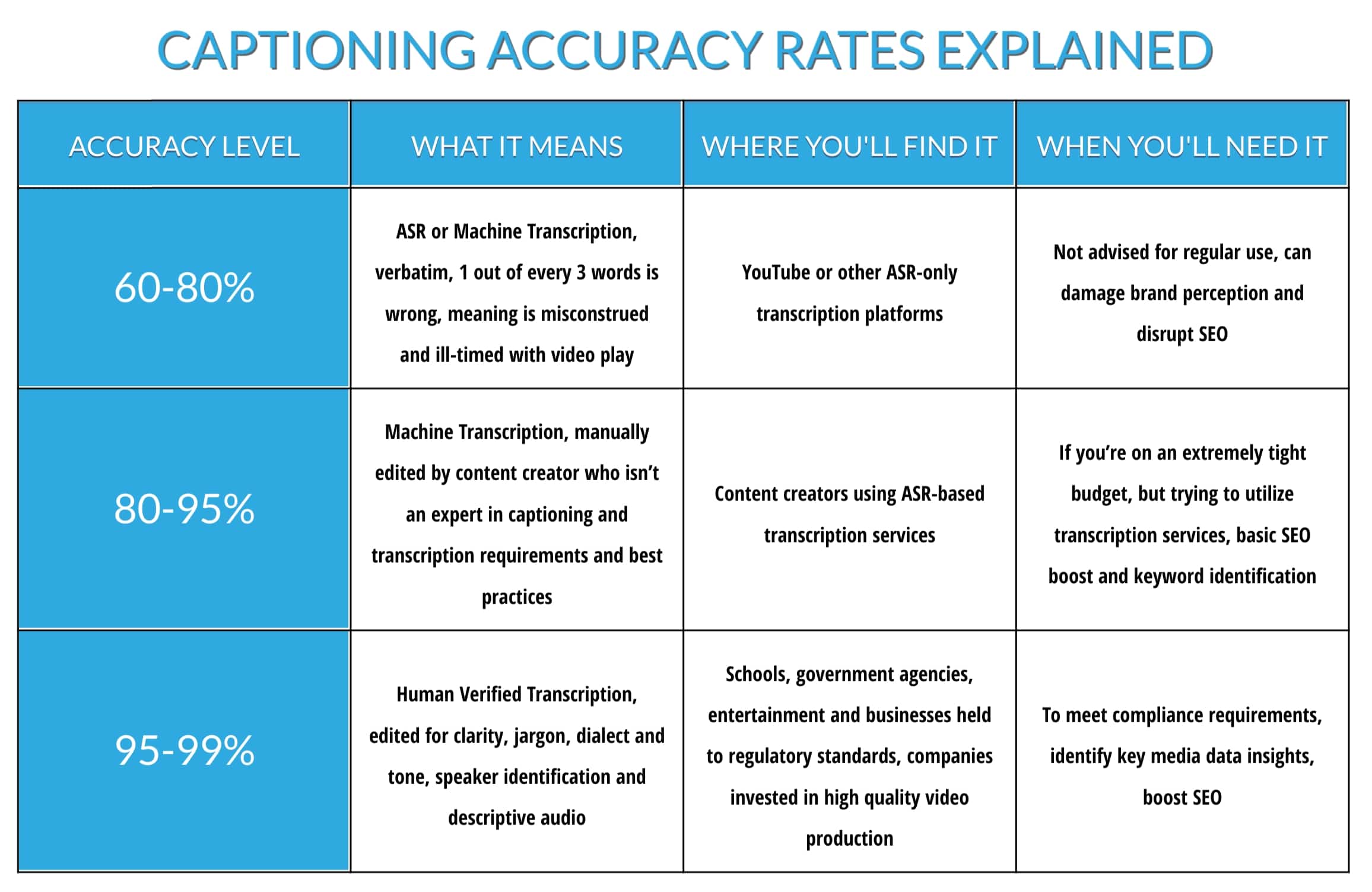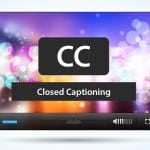Video Captioning Basics: Best Practices for Compliance and Video Performance The following video captioning basics…

Video Captioning Accuracy Levels Explained
Understanding video captioning accuracy rates is imperative to selecting the right captioning and transcription solution for your needs. If your industry is held to state, federal or international regulatory standards, then the choice is made for you – the highest level of captioning accuracy is required for compliance. But if you’re not held to those standards, or perhaps creating video or audio used for an unregulated purpose, like marketing collateral for example, then it’s time to understand all accuracy levels, where you’ll find them, and when you will use each.
What are video captioning accuracy levels?

Why is high video caption accuracy required for compliance?
Good question… On September 22, 2016, the FCC published a final ruling on the quality requirements for closed captioning, making video programmers and content owners directly responsible for providing evidence to the FCC. This action was created to ensure and confirm that their content meets the best in accuracy standards. As noted by the committee, video captioning is intended to “replicate the hearing listeners’ aural experience.” The ruling states that captions must be highly accurate to provide a full experiential auditory reality.
What does the highest accuracy level include?
There are four main areas that the FCC has focused on in their efforts to provide a quality captioning experience.
Accuracy
- Must match the spoken words in the dialogue, in their original language to the fullest extent possible and include full lyrics when provided on the audio track.
- Need to contain all words in spoken order.
- Proper spelling, including homophones, tense, punctuation, capitalization, and the appropriate representation of numbers.
- No rewriting or paraphrasing dialogue.
- No synonyms can be used to replace actual dialogue.
- Where necessary to understand the dialogue, speaker tone of voice must be represented.
- Where slang and grammatical errors are part of the dialogue, this must be represented.
- Utterances and false starts must also be represented to mirror the hear-persons experience accurately.
- Nonverbal information that is not overtly observable must be included. Examples of non-verbal communication include who is speaking, multiple speakers, music sound tags, sound effects, audience reaction, background noise.
Synchronicity/Timing
- Must coincide with their corresponding dialogue as closely as possible.
- Caption synchronicity must pace at a speed that is legible by the viewer.
Program Completeness
- For “fully accessible” status, content must be captioned from beginning to end of the program without interruption, to the fullest extent possible.
- Re-editing of content requires re-editing of captions.
Placement
- Caption placement and size must provide for easy readability for both the caption content and screen content.
How to start a video captioning strategy?
The most common question we field is, “How do I start a video captioning and audio transcription strategy?” With so much to consider in creating, planning and executing a video caption program, it can all feel a little overwhelming. We understand that and work with hundreds of clients to roll-out their best video captioning and transcription strategy.
Many organizations are required to caption and transcribe their video content to maintain compliance. This only adds to the internal pressure to “get it right”. There is positive news, getting started with a video captioning and audio transcription strategy is much easier than you might think. In this blog, we will break down where to begin and how to build upon the basics to end up with a full-scale captioning and transcription process.
It is nearly impossible to caption and transcribe every media minute in your video library right out of the gate. This article takes a methodical step-by-step approach to create program solutions.
It’s easy to try accurate video captions and transcripts.
 At cielo24 we offer Enterprise level captioning, as well as a self-service web app called Self Serve.
At cielo24 we offer Enterprise level captioning, as well as a self-service web app called Self Serve.
Our Self Serve web app allows you to get started on transcriptions and captions immediately at less than $1/minute. We have built our Enterprise plans around your unique business needs to help satisfy more complex and/or larger amounts of media that need captioning or transcription. Through Enterprise, you also have access to our full suite of video and audio data solutions.
For more information on our video transcription accuracy, captioning and video intelligence solutions, contact us online or call us at 1-855-243-5624. Try video transcription on your own using our easy, affordable, and reliable web app! Let your message be heard (or seen and read!). For more information on our video marketing, transcription, captioning, and video intelligence solutions.




